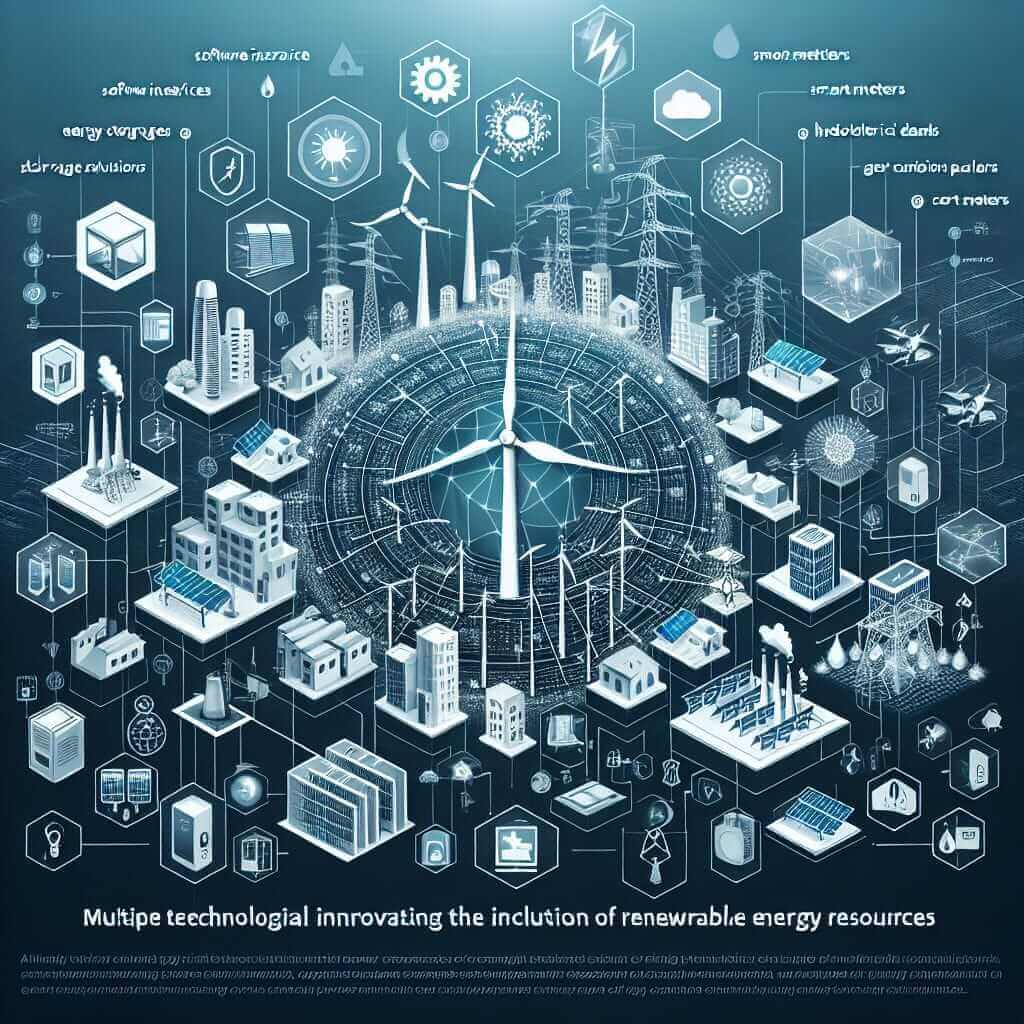The IELTS Reading section is designed to test a range of reading skills. The topics can vary widely, but technological advancements and environmental issues are frequently covered. One such topic is “Technological solutions for renewable energy integration,” which is relevant given the increasing focus on sustainable development. Over the years, this theme has become more common in reading passages, and it’s likely to appear in future exams as well. Understanding this topic can enhance your ability to handle similar passages in the IELTS Reading test.
Reading Passage on Technological Solutions for Renewable Energy Integration
Part 1: Reading Passage
The integration of renewable energy sources—such as wind, solar, and hydropower—into existing power grids presents several challenges and requires innovative technological solutions. These solutions aim to ensure a smooth transition to a sustainable energy future while maintaining grid stability and reliability.
One significant technological solution is the deployment of advanced energy storage systems. Batteries, supercapacitors, and flywheels are being developed to store excess energy generated during peak production times and release it when demand is higher. This capability helps to balance supply and demand effectively.
Another vital technology is the implementation of smart grids. Smart grids employ digital communications technology to monitor and manage the flow of electricity from various sources. These grids can quickly detect outages and reroute power to minimize disruptions. Furthermore, they allow for better integration of distributed energy resources, providing more flexibility and resilience to the grid.
Grid management technologies also play a crucial role. Advanced forecasting algorithms and real-time data analysis enable grid operators to anticipate fluctuations in renewable energy production and adjust accordingly. These technologies help to optimize the grid’s performance and improve energy efficiency.
Moreover, power electronic devices such as inverters and converters are essential for integrating renewable energy sources into the grid. These devices convert renewable energy into a form compatible with the grid’s electrical standards, ensuring a stable and reliable power supply.
Part 2: Questions
Task: Read the passage above and answer the following questions.
1. Multiple Choice Questions
-
What is the primary goal of advanced energy storage systems?
- A. To generate electricity
- B. To store excess energy for later use
- C. To monitor the power grid
- D. To convert renewable energy into usable forms
-
What technological solution helps to detect outages and reroute power quickly?
- A. Power electronic devices
- B. Advanced energy storage systems
- C. Smart grids
- D. Grid management technologies
2. Identifying Information (True/False/Not Given)
-
Deploying advanced energy storage systems helps to balance supply and demand.
- A. True
- B. False
- C. Not Given
-
Smart grids solely rely on human operators to manage the flow of electricity.
- A. True
- B. False
- C. Not Given
3. Summary Completion
Complete the summary using words from the box.
Energy storage systems such as and help store excess energy. Smart grids use technology to manage electricity flow and detect outages. Power electronic devices like are crucial for converting renewable energy.
- A. batteries
- B. supercapacitors
- C. digital communications
- D. inverters
Part 3: Answers and Explanations
Answers
- B. To store excess energy for later use
- C. Smart grids
- A. True
- B. False
- (batteries, supercapacitors, digital communications, inverters)
Explanations
- Advanced energy storage systems are designed to store excess energy and release it when necessary, balancing supply and demand.
- Smart grids use digital communications technology to monitor and manage the flow of electricity, thereby quickly detecting outages and rerouting power.
- The passage states that energy storage systems help balance supply and demand, making the statement true.
- Smart grids utilize digital communications technology rather than solely relying on human operators.
- The summary completion involves matching the words to the technologies described in the passage.
Common Errors and Vocabulary
Common Errors
- Misunderstanding the Passage: Many students misinterpret the passage due to unfamiliar vocabulary or complex sentence structures. Focus on understanding the context and usage of each term.
- Overlooking Keywords in Questions: Always pay attention to the keywords in both the passage and questions to avoid confusion.
Difficult Vocabulary
-
Grid Stability: Refers to the ability to maintain a stable and reliable electricity supply.
- Noun
- /ɡrɪd ˈstəb.ɪl.ɪ.ti/
- The technical measures required to maintain grid stability are becoming more advanced.
-
Inverters: Devices that convert direct current (DC) into alternating current (AC).
- Noun
- /ɪnˈvɜː.tər/
- Inverters are crucial for integrating renewable energy sources into the electrical grid.
Language Structures
- Relative Clauses: Use them to add extra information about a noun without starting a new sentence.
- Example: “Smart grids, which employ digital communications technology, can quickly detect outages.”
- Passive Voice: Often used in scientific and technical texts to emphasize the action rather than the subject.
- Example: “Advanced energy storage systems are being developed to store excess energy.”
Recommendations for High IELTS Reading Scores
- Practice Regularly: Regularly practice with IELTS reading materials to improve your speed and comprehension.
- Expand Vocabulary: Focus on building your academic and technical vocabulary, particularly in areas like renewable energy and technology.
- Understand the Test Format: Familiarize yourself with different question types and formats, such as multiple choice, true/false/not given, and summary completion.
- Time Management: Learn to manage your time effectively during the exam to ensure you can complete all sections.
For further reading, explore related articles on our website:
- Challenges in Renewable Energy Adoption
- Technological Advancements in Grid Management
- Technological Solutions to Renewable Energy Challenges

By focusing on these strategies and materials, you’ll be better prepared to tackle the IELTS Reading section confidently.